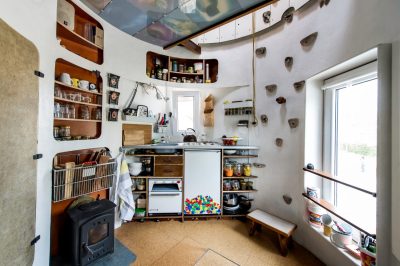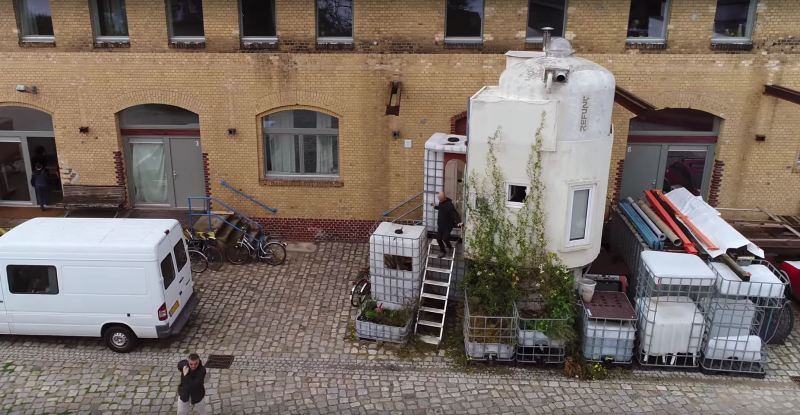[Jan Körbes], an architect living with his daughter in Berlin, specializes in recycling materials. Inspired by discarded grain silos he saw across the Netherlands, he converted one into a micro-home that you would almost expect to see on the surface of mars. The guided tour in the video below give a pretty good feel for the space station feel of the abode.
A lot of the silo house’s design was inspired by [Körbes’] childhood of growing up on boats. It’s exceptionally functional and nearly every nook and cranny of the home can be altered, repurposed, and changed back. For instance: the two pantries on the main floor used to the toilet and shower, but since the silo home is currently set up at ZK/U — Center for Arts and Urbanistics in Berlin — they make use of the facilities there instead.
 True to his specialization of creative recycling , a lot of the materials for the house were either donated, or bought at a steep discount due to various reasons. For instance, the windows were a small, unpopular size for most houses but work well here. This led to an evolving design of the house as it was being built, but everything [Körbes] and his daughter need is present inside of fourteen square metres on three floors.
True to his specialization of creative recycling , a lot of the materials for the house were either donated, or bought at a steep discount due to various reasons. For instance, the windows were a small, unpopular size for most houses but work well here. This led to an evolving design of the house as it was being built, but everything [Körbes] and his daughter need is present inside of fourteen square metres on three floors.
Under the floor on the main level is a bathtub with infrared heating — the cover doubling as the dining table with feet dangling into the tub underneath. The kitchen has a small oven, an old camp stove, and fridge — enough for two people — and the sink uses a foot-activated button so the [Körbes’] use only as much water as they need. A nearby small wood stove with an extendable wood storage basket heats the space.
The house’s electrical (including a solar battery) and water systems are tucked into the basement beside the books, keeping the heavier objects low in such a tall and narrow dwelling. Larger rainwater collection tanks (a hack we’re quite fond of) surrounding the silo house also add ballast in case of storm.
With a two metre ceiling height on the main floor and nearly as much in the bunking quarters upstairs — accessed by a climbing wall, [Körbes] says the space feels much larger than you would expect. Large enough, at least, to host a standing record of a 38-person party. It’s fun to see the ingenuity that goes into tiny living space design. If you missed it, check out these CNC plywood designs for building homes.
[Thanks for the tip, ecoCypherpunk!]















No Place Like Home..
People do some of the same here with grain silos, which are much bigger.
And, empty rocket silos..
Neighbors and pedestrians must be very happy with such dump in the middle of the street.
Or shipping containers. But recycled or not, ain’t cheap.
Grand Designs Shipping Container Home by Patrick Bradley
https://www.youtube.com/watch?v=AFdJrM6pcN0
One thing about Germany (at least the place I’ve been to) is the sheer number of trees everywhere, obscuring the buildings from the street. In this case, you can see the silo from the air, but if you go to Street View, between the trees and a wall surrounding the premises, the silo is invisible from the road: https://goo.gl/maps/d4DRUejKTaP2
that is actually like 5 miles from my house
Yet, somehow, HIS is a Mobile Home! ????
Interesting.. Buckminster Fuller was inspired by grain silos as a template for low-cost housing back in the 1960s. It’s where he started for his Dymaxion house.
If recycling requires significant compromises with regard to the qualities of the finished product, and high energy, labour and material costs in the conversion it may well be that it is not worth the trouble and the concept of sustainability would be better served by improving material reprocessing methods. As for architecture in particular there is a big problem with houses being built to maximise features for a given cost and little thought put into how to build them so that they can be renovated more efficiently. Unfortunately it is often easier to demolish a structure completely and start from scratch, which is obviously wasteful.
One could say the housing market has really “tanked”!
I want to build a castle using four of those concrete silos made of interlocking blocks for the corner towers. Wouldn’t need the external cable banding since they wouldn’t be full of grain or silage exerting lots of outward pressure.
Assembled with construction adhesive, they should hold together. To fit windows and doors, leave out some blocks and cast concrete headers, jambs and lintels to make the openings sized right.
Go “Old School” with a “Flying Buttress”..
Fun, but to give a false impression of internal space, one of the photos is made in airbnb style, i.e. by holding camera as close as it is possible to a one of the walls.
Well, even my dated Nikon 20mm (90°, but no fisheye,) needs to be backed up to get 2 walls of a room. Cameras don’t pan as our eyes do. Kudos to the now-“old” Instamatics w a panoramic lens. Used to have to take many overlapping shots and virtually, or literally, cut ‘n paste slices. Backing up to get the wider shot is a gimmee. Glad he was no dunce and did so. We all get it.
Yes, and thanks to wide angle lenses. I would not like to live with a ceiling height of only 2m, being 1,95m tall. I mean, it’s OK for a week on a boat trip, but not for regular living. I am glad my apartment is 3,30m high
Every real estate photo is done like that!
But yes, 2m ceilings seems very low, must give us a very claustrophobic feel. There are people who’d scrape their heads on that! 2.3m is a standard low ceiling.
It would fit right in between these houses created by Tom Gauld in the comic Mooncop:
http://www.laboiteverte.fr/wp-content/uploads/2016/09/Tom-Gauld-Mooncop-04.jpg
Nice!
how about hackaday construction tutorials in wood and concrete (or other ‘weirder stuff)
How about Instructables.com?
If this is some kind of showcase for the architect, I wouldn’t be employing him based on it.
The Tiny House™ movement certainly tests the limits of consumerism and minimalism.
Use the trademark sign on “The Tiny House”… testing the limits of consumerism… I see what you did there.
I don’t really get people that build “Tiny Houses”. To complete such a project I would think that a person must really posses a joy of making. But then, they move in to a tiny space with no room for tools or supplies? To me that would be like cutting off my dominant arm, leg and eye!
I was going to make a critical, albeit non-snarky, reply to your comment, but then found myself agreeing with you.
But, not the “people that build “Tiny Houses”, rather the people that choose to live in them. I’m interested in having a Poquito Casa (marcas registratas) out on the farm, but that is because I already am drowning in too much stuff/clutter, and moving into one would force me to re-prioritize my life. Having fewer things that “own” me, would be a lot less stressful.
So, in following the TH movement, I find most of the people that live in one, are not necessarily “makers”, but people who sincerely desire to reduce their carbon footprint and have a residence that doesn’t gobble up farmland or forest.
Tiny House communities are forming, and these usually have a “commons” area/building where things that are seldom used by any individual, washing machines for instance, or tools (makerspace) are shared by the community. Such communities are planned near mass transit corridors to reduce automobile ownership/costs/pollution. Yet, these communities still allow for individuals to grow vegetables or flowers and other expressions of individuality.
I imagine, that if I do build/buy a TH for the farm, I will still need a decent sized workshop for my woodworking tools, electronics test bench, welders, et cetera, et cetera, et cetera…
(Until the Tiny Shop craze kicks in…)
B^)
Why not build your tiny house as a hacker-space / maker-space project? That way you get the fun of building a tiny house, others can learn from your project, and you don’t have to buy or rent tools just for one project.